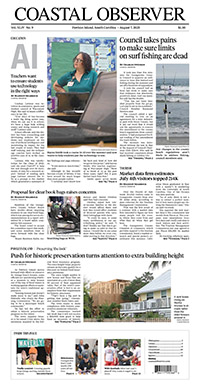Elections
Capital project sales tax narrowly wins voter approval

A 1-cent local sales tax to pay for infrastructure projects won approval from Georgetown County voters this week by a margin as thin as a dime, according to the preliminary results.
Voters rejected a second penny tax that would have provided a property tax credit by an even narrower margin: 64 votes out of 35,164 that were cast in the referendum.
A recount of votes for the local option tax is planned for Tuesday, according to Aphra McCrea, director of Voter Registration and Elections. Recounts are required by state law when the margin of victory is less than 1 percent.
The extra penny that voters approved will be added to the state 6-cent sales tax starting in May and remain in effect for eight years. The revenue will pay for 22 priority capital projects totaling $74 million. Any additional revenue will be applied to a list of 19 contingency projects, starting with $1 million toward a $36 million creek dredging project in Murrells Inlet.
The capital project tax failed to win support in two of the four Murrells Inlet precincts. It also failed in two of the five Pawleys Island precincts.
It also failed in four of the five precincts in the city of Georgetown, where funding for a project to cut down oak trees for a road widening project sparked opposition.
The capital projects tax had an 11 vote majority out of 18,803 cast on the Waccamaw Neck, according to the preliminary results. Those votes were 54 percent of all the votes cast.
Countywide, the tax passed by 754 votes, 2 percent of the 34,392 cast.
There are $42 million in water and/or sewer projects on the priority list. The most expensive is a $13.3 million sewer project in the rural Sampit community.
Tommie Kennedy, executive director of the Georgetown County Water and Sewer District, said he will ask the board to approve funds to start engineering work even though the project is ninth on the list.
“It will take a year or more to design and permit a project,” he said. “We’ll upfront that money just to get the ball rolling.”
While public funds couldn’t be used to advocate for the tax, Kennedy said the district contributed to the campaign because its funding doesn’t come from tax revenue.
“The projects are so important,” he said.
But they were also very local, which Kennedy said made it a hard sell to people who were looking for a direct benefit to themselves.
The project list, by law, was created by a six-member commission. It traveled the county for six months explaining the process and soliciting ideas. The only restriction was that the projects had to be sponsored by a government entity capable of carrying them out.
“We ran a process that was very transparent and very connected to the community,” said Mark Hawn, who chaired the commission.
Yet he also saw that the pair of taxes generated heated opposition in some areas.
“We didn’t know that we’d have as much controversy related to the Neck and zoning that emerged late summer,” Hawn said.
Some area residents called for the defeat of the two sales tax questions as a way to punish Georgetown County for approving an updated land use plan that they said would increase development.
“That probably is the single biggest item that emerged throughout the process,” Hawn said.
But Waccamaw Neck voters were clearly split. The local option tax
failed by just three votes across the nine precincts.
Along with generating revenue that would be applied as a credit for property tax payers, it would have generated an estimated $3 million annually for local government operations.
Proponents said the average household would save more on property tax than it would pay in sales tax. The difference was due to taxes being paid by nonresidents, particularly tourists.
Some voters said they were reluctant to give the county more money.
Update: This story was updated from the print version after it was confirmed that the local option sales tax ballots would be recounted.




